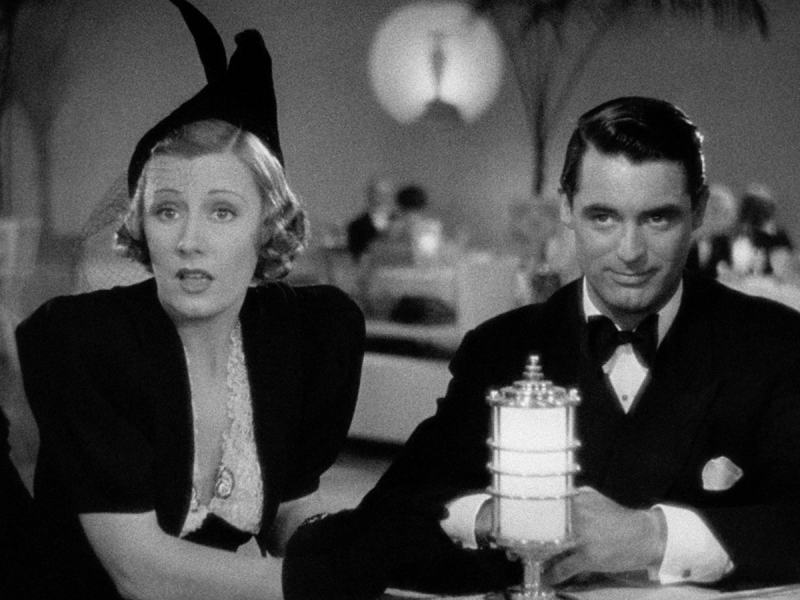The awful truth is that husband and wife Jerry and Lucy Warriner love each other, but, as Lucy notes, there’s “nothing less logical than the truth.” Indeed, Jerry and Lucy’s love seems to defy logic. They are soulmates, but they invite other mates into their beds. They can’t remain separated, but they can’t stand being together. They reveal their innermost feelings to each other, but they can’t resist taking cheap shots at the other’s expense. They decide it would be best for both of them to divorce, but over the course of “The Awful Truth,” they realize they have to stay married.
The success of Leo McCarey’s film seems similarly illogical. It was released in 1937, at the height of the Great Depression. In The New York Times, reviewer B.R. Crisler critiqued the film, writing, “To be frank, ‘The Awful Truth’ is awfully unimportant.” Crisler probably would have preferred “important” 1937 productions like “The Good Earth,” a sobering study of Chinese farmers, or “The Life of Emile Zola,” a tribute to one of France’s greatest writers, or “Snow White and the Seven Dwarfs,” the first animated feature ever produced. “The Awful Truth” has none of the social relevance of “The Good Earth,” none of the prestige of “The Life of Emile Zola” and none of the technological novelty of “Snow White.” Still, this movie was a hit. Why did contemporary audiences enjoy this examination of eccentric elites? McCarey’s film is expertly written and directed and features stellar performances from Irene Dunne and Cary Grant. Yet, the movie is also important because it reflects Depression-era conceptions of class in America.
Jerry and Lucy certainly belong to the upper echelon of New York society. At the beginning of the film, Jerry visits the Gotham Athletic Club, an establishment that only caters to an exclusive clientele. Lucy takes voice lessons with a preeminent European instructor. Jerry wears fine tuxedos. Lucy dons lavish dresses and is decked in furs. They own a spacious home and hire a maid. Their martial problems have no effect on their pocketbooks. After divorcing, they both move into posh apartments and woo people just as prosperous as they are. Lucy takes up with an oil tycoon from Oklahoma while Jerry courts a-stuck-up socialite.
Even as they engage in these romantic pursuits, however, Lucy and Jerry are discontent. Lucy sits in her apartment, staring listlessly into the distance. When Jerry runs into Lucy and her new beau at a dance club, he is riveted as they cut a rug. McCarey was not the only artist interested in the melancholy of the millionaires at this time. As he was shooting “The Awful Truth,” Cole Porter was writing a song called “Down in the Depths on the 90th Floor.” The protagonist of Porter’s work is the proud owner of a penthouse, but she does not possess a paramour. Desperately, she asks, “When the only one you wanted wants another, what’s the use of swank and cash in the bank galore?” McCarey echoes Porter’s sentiment. Money cannot solve Jerry and Lucy’s difficulties when they are together or ease their longing for each other when they are apart.
Porter and McCarey not only express a similar idea, but they also express it in the same way. Porter employs extravagant language in his lyric. No one, not even a despondent debutante, uses the word “galore” in everyday parlance. Likewise, McCarey makes Jerry and Lucy go to ludicrous lengths to demonstrate their shared love. Jerry must best Lucy’s lecherous voice teacher in a jujitsu match. He wreaks havoc on her apartment when her fiancée from Oklahoma visits. To break up Jerry’s affair, Lucy pretends that she is his sister. She regales her rival with tales of his excessive drinking and loose morals. After she says that she works in a nightclub, she treats the society heiress to a salacious (and hilarious) performance.
These absurd acts of devotion illustrate an idea that President Franklin Roosevelt articulated in his First Inaugural Address. Shortly after he assured Americans that “the only thing we have to fear is fear itself,” Roosevelt reminded them that “happiness lies not in the mere possession of money; it lies in the joy of achievement, in the thrill of creative effort.” Jerry and Lucy are ingeniously imaginative as they win each other over. In fact, their inventiveness explains their eventual success in solving their disputes. Lucy’s suitor tempts her with his assets in Oklahoma City. Jerry’s flame offers him a permanent position in New York society. Yet, these promises of wealth cannot compare to the pranks Lucy and Jerry pull on each other. Therefore, they must stay together.
Just as Jerry and Lucy’s creativity rescues their marriage, McCarey’s creativity prevents “The Awful Truth” from becoming dated. While it reflects the rhetoric of its era, Jerry and Lucy’s antics are ageless. Jerry and Lucy’s witty repartee and slapstick shenanigans are so delightful that they defy description. Even B.R. Crisler had to admit that this film was “original and daring.” Perhaps the least logical truth of all is that, 80 years after its release, this “unimportant” diversion is as original and as daring and as entertaining as ever.
Contact Amir Abou-Jaoude at amir2 ‘at’ stanford.edu.
